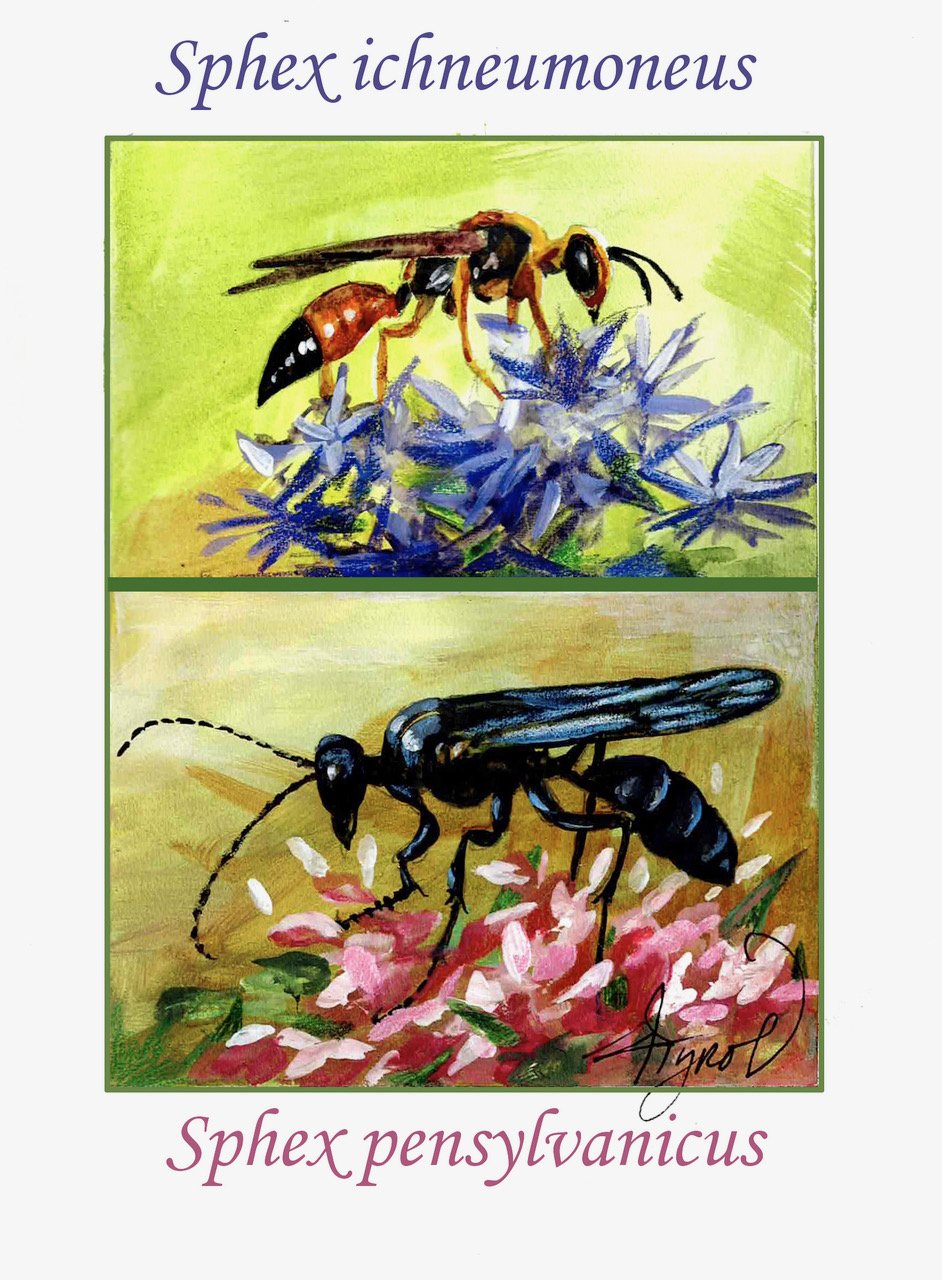Digger wasps come with benefits and misconceptions
October 4, 2024 | By Colby Galliher | The Outside StoryIllustration by Adelaide Murphy Tyrol
On warm days through early fall, you can find two large species of “digger” wasps flitting about late-blooming flowers. Like many wasps, these species elicit strong, often negative reactions from humans. But digger wasps inhabit a critical niche in invertebrate communities – and can lend a natural hand in pest control.
Two of the most common digger wasps in northern New England are the great golden digger wasp (Sphex ichneumoneus) and great black digger wasp (S. pensylvanicus). These hefty wasps first appear in July in the Northeast and persist into fall for as long as daytime temperatures remain elevated. The great golden digger wasp, with a striking combination of orange, black, and gold, averages about half an inch in length. The great black digger wasp is jet black and slightly larger, measuring around 1 inch long.
True to their name, digger wasp females excavate nest tunnels up to a foot deep in loose soil. Nests may be clustered together in patches of bare ground or sand, although each wasp is a solitary nester that only looks after its own offspring. Each female constructs a series of brood chambers that branch off the nest’s primary tunnel. Within each chamber, she deposits an insect she has captured, paralyzed with a sting, and carried to the nest. She lays each egg directly on top of a captive insect and covers the tunnel’s opening with sand or dirt. When the wasp larvae hatch, they will feed on the paralyzed, but still living, prey. The pupae overwinter underground, and when temperatures rise the following summer, the new generation of adults emerges to begin the cycle anew.
Prey species for this “mass-provisioning” include grasshoppers, crickets, katydids and cicadas. Observers have watched robins, tanagers and other birds attempt to steal the catches of female great golden digger wasps as they transport them to their nests.
Digger wasps’ predation of other invertebrates serves a crucial ecosystem need, according to Frank Drummond, professor emeritus of insect ecology and insect pest management at University of Maine. Digger wasps “help regulate the populations of prey species” and thus keep grasshoppers and other herbivorous insects from decimating the plants and trees on which innumerable species rely. Gardeners and farmers, in turn, benefit from a natural check on species that can harm crops, which also reduces the need for insecticide applications.
Predation is not the only contribution digger wasps make to their ecosystem. Although the young rely on prey insects, adult wasps consume nectar. Fine hairs on their bodies transfer pollen granules between flowers as the wasps forage. Drummond also noted that digger wasps “aid in soil aeration and soil-nutrient turn over” when they burrow into soil to establish their nests, another win for farmers and gardeners.
Despite these vital ecosystem services, digger wasps often get a bad rap. Their size and foreboding colors prompt a strong – and usually negative – human reaction.
University of Vermont Extension Entomologist Margaret Skinner said she often fields calls from people alarmed about golden digger wasps in their yards or gardens. “People tend to be concerned when they see them flying around their plants,” she said. “They make a fairly loud noise, are big compared to other wasps, and their colors suggest, ‘Warning, keep away!’”
In truth, digger wasps pose little risk to humans and generally only show aggression when provoked. “A good rule is: if they are not bothering you, don’t bother them,” said Charlene Donahue, a retired Maine Forest Service entomologist, who noted that though their sting is painful, digger wasps will only resort to that defense if harassed.
Farmers and gardeners hoping to attract these wasps to their property as a means of natural pest control have several landscaping options. Native plants that bloom from mid-summer into fall, such as aster, goldenrod, mountain mint, coneflower, ironweed, milkweed and beebalm, will attract digger wasps. Sandy areas or patches of loosely packed earth provide nesting medium. Fields, meadows and gardens untreated by pesticides, which tend to harbor greater numbers of grasshoppers and other prey species, are more likely to support great golden and great black digger wasps by offering a steady stream of prey.
Colby Galliher is a writer who calls the woods, meadows, and rivers of New England home. The Outside Story is assigned and edited by Northern Woodlands magazine and sponsored by the Wellborn Ecology Fund of New Hampshire Charitable Foundation.

